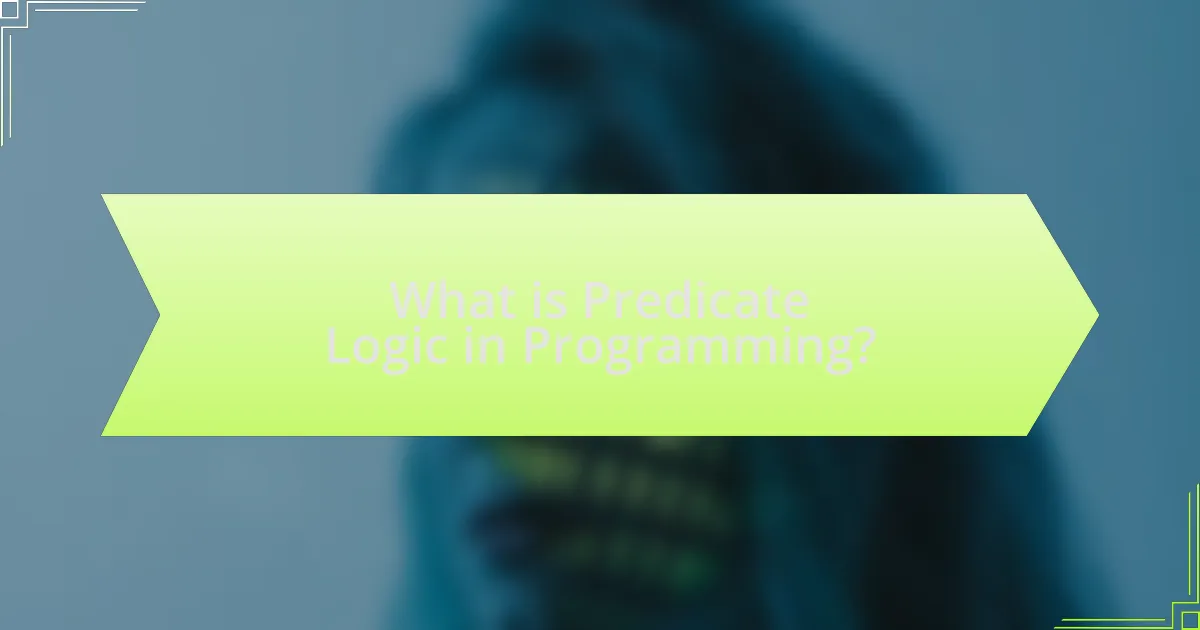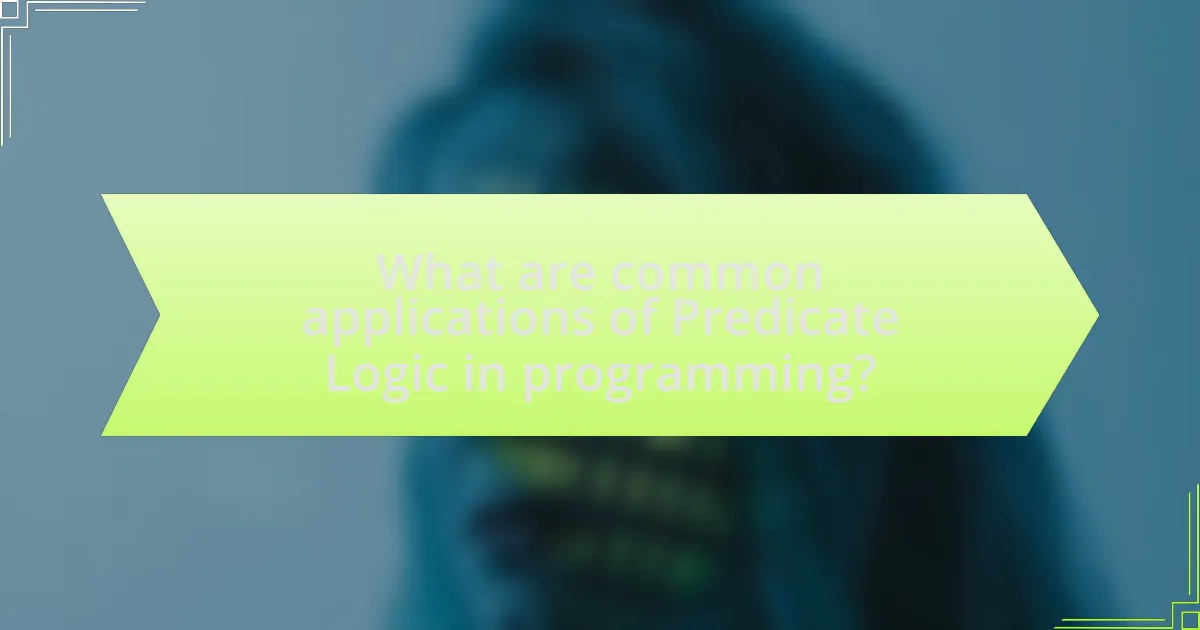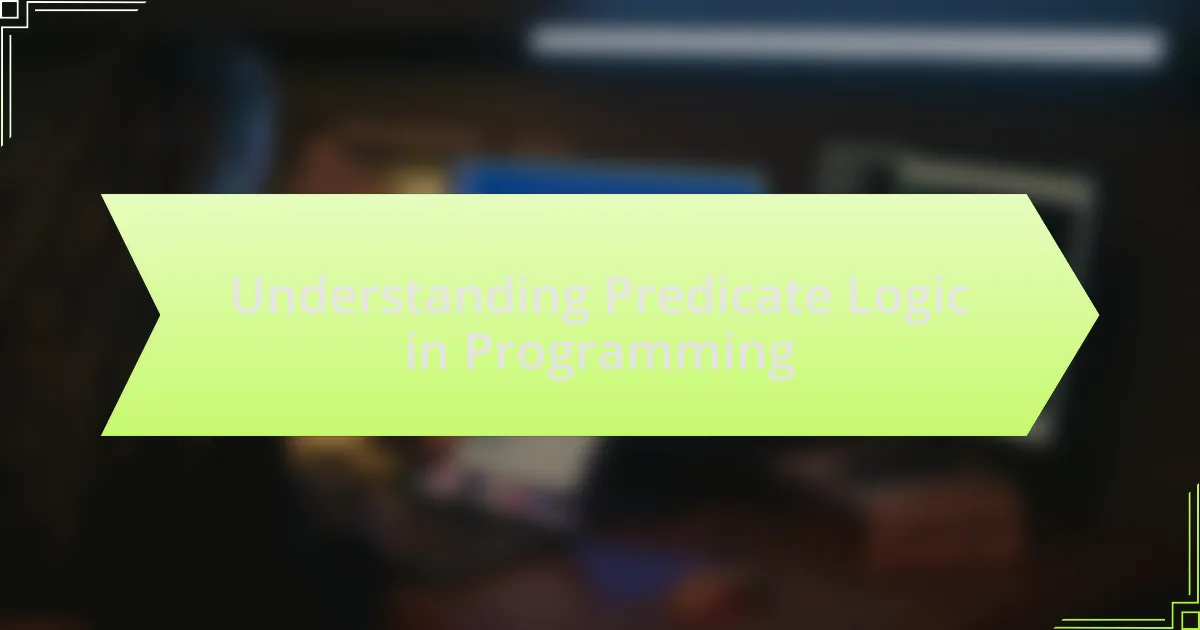Predicate Logic in programming is a formal system that expresses statements about objects and their properties through predicates, which return true or false. This logical framework is essential for creating conditions that govern algorithms and data structures, enhancing program correctness and enabling automated theorem proving. The article explores the differences between Predicate Logic and other logic forms, its fundamental principles, representation in programming languages, and its significance in decision-making processes. Additionally, it discusses the role of Predicate Logic in enhancing code readability, its applications in database query languages and artificial intelligence, and best practices for effective implementation in programming.

What is Predicate Logic in Programming?
Predicate logic in programming is a formal system used to express statements about objects and their properties through predicates, which are functions that return true or false. This logical framework allows programmers to create conditions and rules that govern the behavior of algorithms and data structures, facilitating reasoning about program correctness and enabling automated theorem proving. Predicate logic is foundational in areas such as database query languages, where it underpins the structure of SQL, allowing for precise data retrieval based on specified conditions.
How does Predicate Logic differ from other forms of logic?
Predicate Logic differs from other forms of logic primarily by its ability to express statements involving quantifiers and predicates, allowing for more complex relationships between objects. Unlike propositional logic, which deals only with whole statements that are either true or false, Predicate Logic incorporates variables and quantifiers such as “for all” and “there exists,” enabling it to represent more nuanced logical expressions. This capability allows Predicate Logic to handle statements about properties of objects and their relationships, which is essential in fields like mathematics and computer science for formal reasoning and programming languages.
What are the fundamental principles of Predicate Logic?
The fundamental principles of Predicate Logic include the use of predicates, quantifiers, and logical connectives to form statements about objects and their properties. Predicates express properties or relations, quantifiers specify the extent of the statements (such as “for all” or “there exists”), and logical connectives (like AND, OR, NOT) combine these statements to create complex expressions. These principles enable the representation of logical relationships in a structured manner, facilitating reasoning and inference in programming and mathematics.
How is Predicate Logic represented in programming languages?
Predicate Logic is represented in programming languages primarily through the use of predicates, which are functions that return true or false based on the input values. In languages like Prolog, predicate logic is directly implemented, allowing for the expression of logical statements and relationships. For example, a predicate can be defined to represent a relationship, such as “parent(X, Y)” to indicate that X is a parent of Y.
In other programming languages, such as Python or Java, predicate logic is often represented using boolean expressions and functions. For instance, a function can be created to evaluate conditions, returning a boolean value that reflects the truth of the logical statement. This allows for the implementation of logical operations, such as conjunction (AND), disjunction (OR), and negation (NOT), which are fundamental to predicate logic.
The representation of predicate logic in programming languages facilitates reasoning about data and enables the development of algorithms that can make decisions based on logical conditions. This is evident in the use of conditional statements and loops, which rely on logical evaluations to control the flow of execution.
Why is Predicate Logic important in programming?
Predicate Logic is important in programming because it provides a formal framework for reasoning about the properties of programs and their behavior. This logical structure enables programmers to express complex conditions and relationships clearly, facilitating the verification of program correctness and the development of algorithms. For instance, predicate logic is foundational in the design of programming languages and in the implementation of automated theorem proving, which ensures that software behaves as intended.
What role does Predicate Logic play in decision-making processes?
Predicate Logic plays a crucial role in decision-making processes by providing a formal framework for representing and reasoning about propositions and their relationships. This logical structure allows for the formulation of clear, unambiguous statements that can be evaluated as true or false, which is essential for making informed decisions. For instance, in programming, Predicate Logic enables the creation of conditional statements that guide the flow of execution based on specific criteria, thereby influencing outcomes based on logical deductions. The effectiveness of Predicate Logic in decision-making is evidenced by its application in various fields, including artificial intelligence and database querying, where it facilitates complex reasoning and data retrieval based on logical conditions.
How does Predicate Logic enhance code readability and maintainability?
Predicate Logic enhances code readability and maintainability by providing a clear and formal structure for expressing conditions and relationships within the code. This structured approach allows developers to easily understand the logic behind the code, as predicates can succinctly represent complex conditions in a way that is both intuitive and precise. For instance, using predicates can reduce ambiguity in conditional statements, making it easier for programmers to follow the flow of logic and identify potential issues. Furthermore, the use of Predicate Logic facilitates easier modifications and updates to the code, as changes to logical conditions can be made without extensive rewrites, thereby improving maintainability. Studies have shown that codebases utilizing formal logic structures tend to have lower defect rates and are easier to navigate, supporting the assertion that Predicate Logic significantly contributes to both readability and maintainability in programming.

What are the key components of Predicate Logic?
The key components of Predicate Logic are predicates, subjects, quantifiers, and logical connectives. Predicates express properties or relations, while subjects refer to the entities being discussed. Quantifiers, such as “for all” or “there exists,” specify the scope of the predicates, and logical connectives, including “and,” “or,” and “not,” combine statements to form complex expressions. These components work together to create formal statements that can be evaluated for truth values, making Predicate Logic a foundational aspect of mathematical logic and programming languages.
What are predicates and how are they used in programming?
Predicates are expressions that evaluate to true or false based on the values of their variables, commonly used in programming to make decisions. In programming, predicates serve as conditions in control structures like if statements, loops, and filters, allowing developers to execute code selectively based on logical evaluations. For example, in a programming language like Python, a predicate can be a function that checks if a number is even, returning true for even numbers and false for odd ones. This functionality is crucial for implementing algorithms that require conditional logic, such as searching and sorting, where predicates determine the flow of execution based on specific criteria.
What is the significance of quantifiers in Predicate Logic?
Quantifiers in Predicate Logic are significant because they allow for the expression of statements about the existence or universality of elements within a domain. Specifically, the existential quantifier (∃) asserts that there is at least one element in the domain that satisfies a given property, while the universal quantifier (∀) indicates that all elements in the domain satisfy that property. This capability is crucial in programming and formal reasoning, as it enables the formulation of precise conditions and rules that govern the behavior of algorithms and data structures. For instance, in database queries, quantifiers help define conditions for retrieving data, ensuring that the logic accurately reflects the intended requirements.
How do logical connectives function within Predicate Logic?
Logical connectives in Predicate Logic function as operators that combine or modify propositions to form more complex statements. These connectives include conjunction (AND), disjunction (OR), negation (NOT), implication (IF…THEN), and biconditional (IF AND ONLY IF). Each connective has a specific truth-functional role, determining the truth value of the compound statement based on the truth values of its components. For instance, the conjunction is true only if both propositions are true, while disjunction is true if at least one proposition is true. This systematic approach allows for the construction of logical expressions that can represent complex relationships and reasoning in programming contexts, such as in algorithms and decision-making processes.
How do programming languages implement Predicate Logic?
Programming languages implement Predicate Logic primarily through the use of logical operators and constructs that allow for the expression of conditions and relationships. For instance, languages like Prolog are designed specifically for logic programming, where predicates are defined and queried directly, enabling the representation of facts and rules. In more general-purpose languages such as Python or Java, Predicate Logic is implemented using boolean expressions, conditional statements (like if-else), and functions that return boolean values, allowing developers to create complex logical conditions. This implementation is supported by the underlying principles of formal logic, which provide a structured way to reason about truth values and relationships, ensuring that the logical constructs behave consistently according to established logical rules.
What are examples of Predicate Logic in functional programming languages?
Examples of Predicate Logic in functional programming languages include the use of predicates in languages like Haskell and Prolog. In Haskell, predicates are often implemented as functions that return Boolean values, allowing for logical expressions to be evaluated, such as in the use of the filter function to select elements based on a condition. In Prolog, predicate logic is fundamental, as it uses facts and rules to infer conclusions, enabling complex queries and logical reasoning. These implementations demonstrate how functional programming languages leverage predicate logic to facilitate decision-making and problem-solving through formal logical constructs.
How is Predicate Logic utilized in object-oriented programming?
Predicate Logic is utilized in object-oriented programming to define and enforce constraints on object properties and behaviors through assertions and method contracts. This logical framework allows developers to express conditions that must hold true for objects, enabling reasoning about program correctness and facilitating automated verification processes. For instance, in languages like Java, the use of assertions allows programmers to specify preconditions and postconditions for methods, ensuring that certain logical conditions are met during execution. This application of Predicate Logic enhances code reliability and maintainability by providing a formal basis for reasoning about the state and behavior of objects within a program.

What are common applications of Predicate Logic in programming?
Common applications of Predicate Logic in programming include formal verification, database query languages, and artificial intelligence. In formal verification, Predicate Logic is used to prove the correctness of algorithms and systems by expressing properties that must hold true. In database query languages, such as SQL, Predicate Logic enables the formulation of complex queries through logical expressions that filter data based on specific conditions. In artificial intelligence, Predicate Logic facilitates knowledge representation and reasoning, allowing systems to infer new information from existing facts. These applications demonstrate the utility of Predicate Logic in enhancing the reliability, efficiency, and intelligence of programming practices.
How is Predicate Logic used in database query languages?
Predicate Logic is used in database query languages to express complex queries and conditions in a formalized manner. It allows users to formulate statements about data that can be evaluated as true or false, enabling precise data retrieval. For instance, SQL, a widely used database query language, employs predicate logic through its WHERE clause, which specifies conditions that must be met for records to be selected. This logical framework supports operations such as filtering, joining tables, and enforcing constraints, thereby enhancing the expressiveness and functionality of database interactions.
What are the advantages of using Predicate Logic in SQL?
The advantages of using Predicate Logic in SQL include enhanced query expressiveness, improved data integrity, and the ability to perform complex logical operations. Predicate Logic allows for precise conditions in SQL queries, enabling users to filter data based on specific criteria, which leads to more accurate results. Additionally, it supports the formulation of constraints and rules that maintain data integrity, ensuring that only valid data is entered into the database. Furthermore, Predicate Logic facilitates the combination of multiple conditions using logical operators such as AND, OR, and NOT, allowing for sophisticated data retrieval and manipulation. These features collectively contribute to more efficient and reliable database management.
How does Predicate Logic facilitate data validation?
Predicate Logic facilitates data validation by providing a formal framework to express constraints and conditions that data must satisfy. This logical structure allows programmers to define specific rules for data integrity, ensuring that only valid data enters a system. For instance, in database management, predicate logic can be used to enforce rules such as “age must be greater than 18” or “email must match a specific format.” By applying these logical predicates, systems can automatically validate incoming data against predefined criteria, reducing errors and maintaining data quality.
What role does Predicate Logic play in artificial intelligence?
Predicate Logic serves as a foundational framework in artificial intelligence by enabling the representation of knowledge and reasoning about the world. It allows AI systems to express complex relationships and make inferences based on logical statements. For instance, predicate logic facilitates the development of algorithms that can deduce new information from existing facts, which is essential in areas such as natural language processing and automated theorem proving. The use of predicate logic in AI is evidenced by its application in systems like Prolog, a programming language specifically designed for logic programming, which utilizes predicate logic to solve problems through logical inference.
How does Predicate Logic contribute to knowledge representation?
Predicate Logic contributes to knowledge representation by providing a formal framework for expressing facts and relationships in a structured manner. This logical system allows for the representation of complex statements about objects and their properties, enabling reasoning about those statements. For instance, Predicate Logic uses quantifiers and predicates to articulate general truths and specific instances, which facilitates automated reasoning in artificial intelligence applications. The ability to represent knowledge in this way is foundational for systems that require logical inference, such as expert systems and knowledge-based systems, where accurate representation and manipulation of information are critical for decision-making processes.
What are the implications of Predicate Logic in machine learning algorithms?
Predicate Logic significantly enhances machine learning algorithms by providing a formal framework for reasoning about data and relationships. This logical structure allows algorithms to represent complex relationships and make inferences based on given facts. For instance, in natural language processing tasks, predicate logic can be utilized to improve understanding of sentence structures and semantics, enabling more accurate interpretations of user queries. Additionally, it facilitates the development of knowledge-based systems where rules can be explicitly defined, leading to better decision-making processes. The integration of predicate logic into machine learning has been shown to improve performance in various applications, such as automated reasoning and knowledge representation, as evidenced by research that highlights its effectiveness in enhancing algorithmic accuracy and interpretability.
What are best practices for using Predicate Logic in programming?
Best practices for using Predicate Logic in programming include clearly defining predicates to represent logical statements, ensuring that predicates are concise and unambiguous, and using logical operators effectively to combine predicates. Clear definitions help in maintaining code readability and facilitate debugging. Conciseness prevents confusion and enhances performance, while effective use of logical operators allows for complex conditions to be expressed succinctly. For instance, in programming languages like Prolog, predicates are foundational, and their clarity directly impacts the efficiency of queries and rule definitions.
How can developers effectively implement Predicate Logic in their code?
Developers can effectively implement Predicate Logic in their code by utilizing logical expressions to evaluate conditions and make decisions based on those evaluations. This can be achieved through the use of conditional statements, such as if-else constructs, which allow developers to express complex logical relationships using operators like AND, OR, and NOT. For instance, in programming languages like Python or Java, developers can create predicates as functions that return boolean values, enabling them to filter data or control program flow based on specific criteria. The effectiveness of this implementation is supported by the fact that Predicate Logic provides a formal framework for reasoning about the truth values of propositions, which is foundational in computer science for tasks such as algorithm design and database querying.
What common pitfalls should programmers avoid when using Predicate Logic?
Programmers should avoid several common pitfalls when using Predicate Logic, including misunderstanding quantifiers, neglecting the importance of domain specificity, and failing to account for logical equivalences. Misunderstanding quantifiers, such as confusing “for all” with “there exists,” can lead to incorrect assumptions about the truth of statements. Neglecting domain specificity can result in predicates that do not accurately reflect the intended scope of variables, leading to erroneous conclusions. Additionally, failing to account for logical equivalences may cause programmers to overlook simpler or more efficient formulations of logical expressions, which can complicate code unnecessarily. These pitfalls can significantly impact the correctness and efficiency of logical reasoning in programming.



